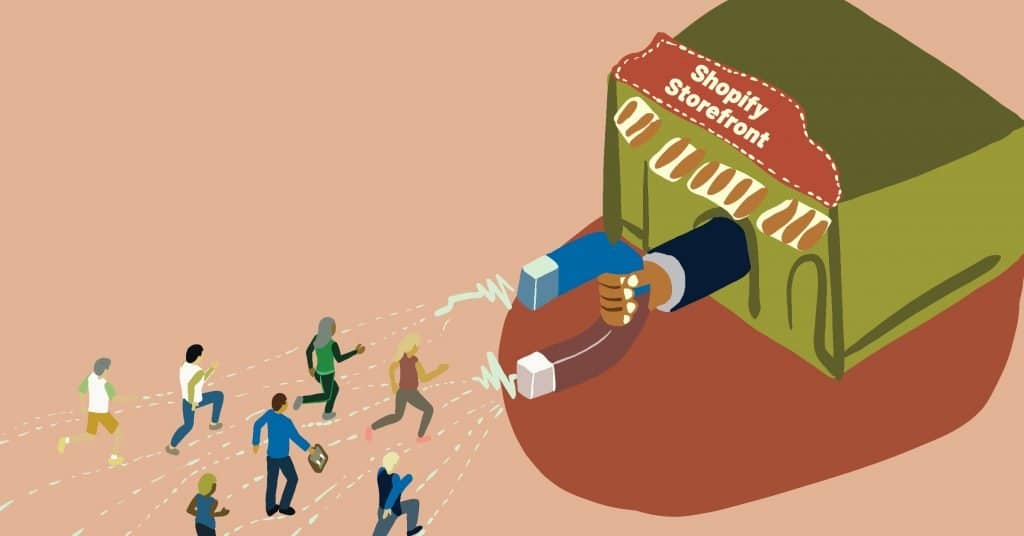How many times in the past few articles did we say “consider sending an email?” You don’t have to go back and count; we’ll save you the trouble and tell you: it was a lot.
Email marketing is insanely cost-effective and drives results better than any other avenue. That’s due in part to the fact that people have to opt in to receive most of those emails, so they’ve already self-selected and shown at least some interest in your products.
Download Now:
The Complete Shopify Lifecycle Marketing Playbook
But even with the massive average ROI, email marketing is not going to push the needle on your sales if you or someone else on your marketing team is sitting there typing out every message that’s sent. Even if you’re just copying and pasting from a slate of messages—you can’t speak to your customers’ individual needs through batch and blast email campaigns.
Which is why you need to automate your email marketing. Here’s a high-level look at how you automate your emails and drive more sales with QDM Lifecycle Marketing.
Use Data to Drive Email Performance
The best lifecycle marketing decisions are made with data. It’s tempting to assume you know what people need or want, but just because you like something doesn’t mean others do. Here are just a few things you shouldn’t assume about your customers and email processes:
- That customers want or need certain products. Instead, use data that comes from website analysis, focus groups and market research to make decisions about what to offer and when to offer it based on where a customer is in their journey.
- When customers are most likely to open emails. You can start with benchmarking from reputable organizations, but remember that your customers are unique to you. You might read that the highest email open rate on average happens at 10 am or 1 pm, but those statistics based on other industries and customers. What works best for your audience and subscribers will be different. For some businesses, subscribers are most likely to purchase on weekends. For other, early morning emails might be more effective.
- How your customers are responding to emails. Without analytics, you don’t know what’s working and what’s not. Did that early Tuesday email generate a lot of opens, or are you getting more traffic from messages sent on Saturday? What images, calls to action and offers are leading to the most clicks? Using software to gather this type of customer data automatically helps you understand how best to manage lifecycle marketing email campaigns.
Marketing automation helps you gather large amounts of data about your customers, marketing efforts and email campaigns. It also helps you sort through it and turn it into actionable reports, so you can make informed decisions about future marketing campaigns.

Automate Messaging for Certain Campaigns
Automation can also solve simpler problems than data gathering and management. For example, how do you ensure everyone who abandons their cart gets a follow-up email?
You could look at the data and metrics on a daily basis, make a list of people with items sitting in their carts and kick off emails manually. But, first of all, who has that kind of time? Not a retailer growing a Shopify store.
And even if you could find the time for unnecessary tedium in your life, the opportunities for error here are legion. Some errors might include missing abandoned carts so emails aren’t sent or sending emails to the wrong accounts and annoying perfectly good customers who did finish their purchases. Even if they aren’t annoyed, they’ll be confused and wonder if their order is coming after all… That’s not the kind of customer experience that grows your first-time purchasers into loyal customers!
Automation solves these issues. Experienced email marketers can program emails to kick off once a cart has been abandoned for a certain amount of time. Did someone leave something in their cart for 12 hours? 24 hours? You decide on the effective time to send cart abandonment emails and the content of the message. Then automation kicks in to send the email whenever appropriate.
Here are some other examples of email automation that can support customer relationships and help with lifecycle marketing strategy:
- Post-purchase drip campaigns. A purchase can trigger an email thanking the customer and suggesting other products. But you don’t have to stop at one email. You might create an automated drip campaign of three or four emails that are sent over the course of a month. Those emails keep your shop in the mind of the customer while also slowly providing information about how you can help them.
- Welcome emails. When someone signs up for your newsletter or loyalty program, have an automated welcome email sent to them. Sending an email touchpoint within a day of someone signing up helps cement that initial impression and can provide the person with important information about your shop or program.
- Customer nurturing series. Grow those seedling first-time purchasers into repeat, loyal customers with an automated series of emails meant to engage with them on a regular basis.
- Birthday emails. You obviously aren’t going to check your database daily and send birthday emails. Why would you when you can so easily automate these types of messages to ensure everyone is celebrated at the right time.
Automated emails are incredibly useful, but they don’t diminish your ability to send manual emails. You can design and send emails whenever you want to notify customers of a flash sale or send a special promo code. You can also design those emails ahead of time and schedule them to send whenever you want. That’s handy if you have an audience in another time-zone or a younger audience that tends to check emails later at night.

Segment Your Audience to Drive Higher Conversions
Data and automation isn’t all about sending emails, though. You can turn to these tools to help you send emails to the right people, which drives higher conversion rates. This is known as audience segmentation.
Here are some reasons you might want to segment your audience, so you can send different emails to various groups.
Segment by Demographics
People of different ages, income levels or career statuses may want or need different products. And even more importantly for lifecycle marketing, the reason they need or want those products might be different.
Knowing this lets you send feature/benefit emails that really resonate with individual segments of the audience. Parents, for example, might be concerned with the value and safety of a product while younger, single audiences may be more concerned with the experience of using the product or the values of the manufacturer. Finding the right message to appeal to each group effectively may be different.
Another example of different messaging could relate to income levels. You might market more luxurious products to those with higher incomes and budget-friendly products to those who are currently pinching pennies. Perhaps you offer the same products to everyone, but the way you position them might be different depending on your target audience’s spending habits or disposable income.
Segment by Behavior
The previous purchasing behavior of your audience can help you create more effective messages. For example, some people might regularly buy shirts from your store. Other people might never buy shirts but always show up for hats and scarves.
You might want to offer the shirt crowd a discount on hats and scarves to try to get them to expand their shopping with you. But you could offer the accessories buyers a discount on shirts to drive them into other categories in your shop as well.
You could also use behavior data to segment by offers. You could offer people who buy loyally a bigger discount than other people get, for example. Or you might avoid sending loyal customers re-engagement campaigns when that’s unnecessary and possibly unwanted.
Segment by Geolocation
If you’re a Shopify clothing shop, you might want to send emails recommending favorite products in February. People along the Gulf Coast in the United States are usually wearing short sleeves and even shorts at this point in the year. But those who live in the Northeast or Midwest of the United States are still donning sweaters and puff coats. If you can segment your marketing emails by location, you can correctly target what consumers need in various locations. This is just one example of how segmenting by location in your marketing approach can help you increase conversion rates.
Use Dynamic Design Features for Visually Appealing Emails
While some audiences might prefer straight-text emails with a single no-nonsense link, visual appeal is becoming increasingly important. People don’t want to look at a screen splotched crazily with color and a dozen fonts blinking at them. That’s going to come across as spam and get your emails tossed to the curb real fast.
But adding one or two images and some tasteful, brand-appropriate design that works on mobile and desktop screens alike isn’t a bad idea.
Automation brings dynamic design features to the table. These features make it easy to create customized emails for various people or audience segments. For example, you could have a placeholder in your email for an image. Couple that dynamic design with data from your store, and every person who receives the email might see the last thing they ordered or looked at in your store. Even if that’s unique for every user.
Dynamic design and other automated email marketing features make it much easier to connect organically, grow relationships and provide customer support without having to rely solely on manual communication.

Perform A/B Testing for Continuous Improvement
Remember when we were down on making assumptions? A/B testing is how you get enough information that you don’t have to rely on assumptions.
The basic gist of A/B testing is that you try two versions of the same thing. You guessed: The A version and the B version. In this scenario, As and Bs aren’t the same as they were in school: One of them is probably better, but it’s not necessarily the A.
You test both versions and look at the data to see which one works better. Here’s an example:
Perhaps you want to send an email with a 20% promo code. What subject line is going to get the most opens? You can run some emails with subject line A and some with subject line B to see. When you learn which one performs best, you can use that same subject line formula in future campaigns.
Once you know what subject line works, you can tweak other elements of your email campaigns. Some other things you can test with this method include:
- When you should send an email (days and times)
- How long the subject line should be
- How long the email should be
- Where the links should be inside the email
- Whether one or two images is better (or whether one or no image is better)
- What the CTA should be
You can get as detailed as testing what colors and fonts work or where certain words should be in an email. The goal of A/B testing is to gather information about what works best with your audience. Since your audience changes constantly and customer needs evolve, you should keep testing and making changes to continuously improve the performance of your lifecycle marketing.
Get In Touch to Find Out More
Are you ready to power up your lifecycle marketing and spur on success with your Shopify store? Reach out to Quantum today to find out more about how we can help you put all this advice into action with automated lifecycle and email marketing.
